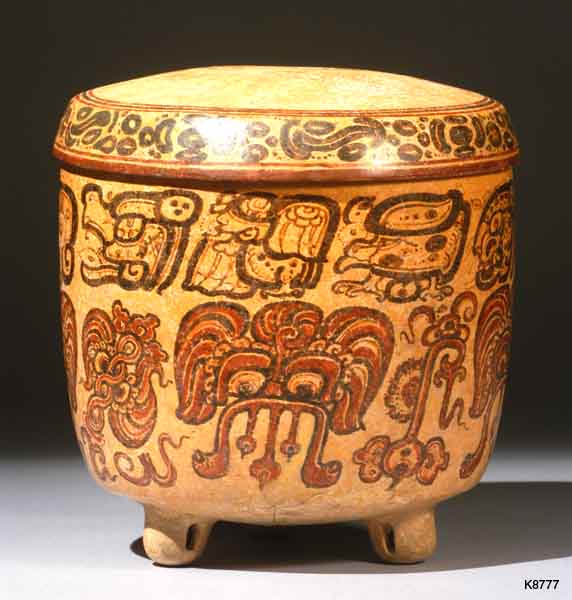Mayavase.com Research Material


|
From Stan Guenter The piece is certainly quite extraordinary. Very interesting EG. The Teo butterflies are quite reminiscent of the vessels from Copan's Sub-Jaguar tomb, (compare with K6195) likely that of B'ahlam Nehn with a date of the early sixth century. The style of the glyphs, as well, indicate a similar date (compare to vessels of Tikal's Wak Chan K'awiil) so we can probably place this Muwaan B'ahlam into the mid-sixth century. It is quite interesting to see that the color scheme of the western Peten ceramic sphere, highlighting red on a golden-yellow background, was already established at this early date. From Nikoai Grube Dear Simon and Stan, Kerr 8777 is truly an extraordinary vessel. The style, as Stan notes, is well within the western Peten tradition. The name of the owner includes the elements Muwaan B'ahlam but I would like to point out that the entire name is much larger, including three more glyphs before the Muwaan head. The three preceding glyphs spell a name, or part of it, which appears in many variations throughout the Maya lowlands. The basic components of this name are invariably T628, David's K'IK' logogram, a form of T128 or the TI' "mouth" sign (often replaced by the head variant), and finally a bird with black markings or darkness symbols covering the eyes (T1058 in Thompson's catalogue). Examples for this name are abundant and include Sacul Stela 1 (here with a very nice bird), the Vase of the 88 Glyphs (here it is the subject of the birth verb and probably refers to one of the avian figures illustrated), Bonampak Stela 3, A4-B4 (apparently part of the full form of Yajaw Chan Muwaan's name), and Kerr 7224. There is also a version of this name on the Lintel from Structure 6 at Bonampak. Here, the "blood" sign is infixed into the mouth of the TI logograph, and the bird head is replaced by the "ch'ak-kab'-na" compound. We know from Yaxchilan, Palenque and other places that this compound substitutes for an avian deity head with jaguar ears, blind eyes and darkness attributes. Apparently, the bird is some kind of blood-sucking or blood-eating raptor, and it is interesting that in most cases, this onomastic element precedes other bird logos such as the Muwaan or Palenque's mysterious 'mat' bird. On Yaxchilan Throne 2, Glyph 3 the T1058 night bird logograph is written with a beautiful full figure variant, and the next glyph is 'muut', which confirms again that the head is that of a bird. Finally, there can be little doubt that the bird head on Dresden 16c, last t'ol, second glyph is the same. Note that in the Dresden example the illustration shows a 'mo'o' Guacamaya, and the text says 'mo-o-o "night bird"-mu-ti. And on Dresden 17c, second column of glyphs we find the same construction, although with a vulture mentioned before. Syntactically, the "night bird" sign should stand for the possessive pronoun (u muut), however, I am not aware of any substitutions between 'u' signs and this bird head. Since the head in almost all cases carries a -na suffix we should rather look for the name of an avian creature ending in -n. I have scanned many dictionaries and have found a couple of birds and blood sucking flying creatures that would fit (ikin 'owl', t'on 'garza tigre', jejen 'chaquiste', xe'n 'mosquito', etc.), but lacking additional constraints and information about the augural connotations of these species this seems to be a difficult task. Maybe you have an idea. From Stan Guenter Nikolai, Thanks for the comments on K8777 and the Flying Bloodsucker name. This guy's name is certainly one of the glyphs I would most like to decipher, for as you point out, it forms part of the name of many, many kings. That said, I am not entirely certain that the name on this vessel fits into the "Bloody-Mouth Axe-Earth God" series. Glyph D on the vessel includes an AJAW face inside the K'IK' logogram, which I think must significantly modify its reading. (Although PSS material rarely refers to the scene painted below, it is interesting to note the bloody-mouthed Teotihuacan butterflies on this vessel in relation to this glyph.) Glyph E does not appear to be a known variant of TI', although the open mouth may provide a reference to such an idea. What caught my eye here is the CHUWEN in the eye of this reptilian critter, which reminds me of the name of Yajaw Chan Muwaan II's father. I wonder if this could not be a logogram for HUH, "lizard". Glyphs D-F, then, would read "X-Lizard-Axe-Earth God". Interestingly, a glyph on El Peru Stela 16 resembles Glyph E, the lizard head (it must be pointed out, though, that the monumental version has a curl nose), although the date on that monument makes it unlikely that this is Muwaan B'ahlam of K8777. Thanks again for the notes on this vase and the Night-Bird God. When I get into camp in a couple of weeks I plan on taking a close look at Stelae 22 and 23 again and perhaps I can find some evidence of these names of Muwaan B'ahlam and we can retrieve some further info. on this king. Cheers, |
|